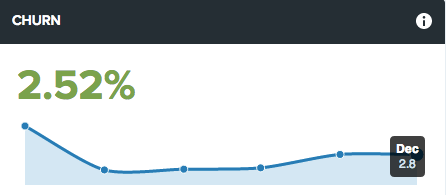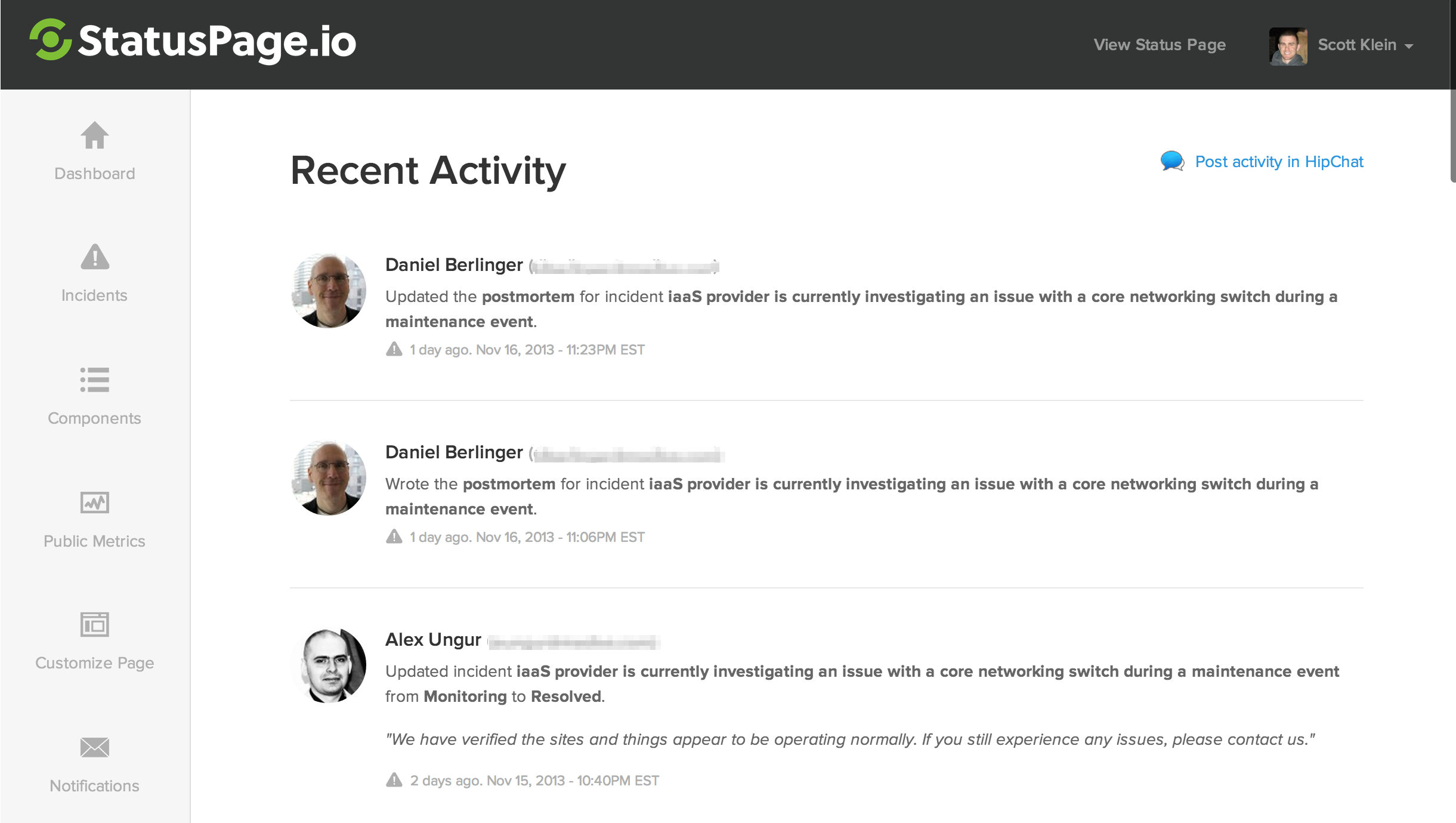Back in July we wrote a post on 5 steps to $5,000 in monthly recurring revenue (MRR) and promised we would write follow up posts for $25k, and $100k in MRR. We're excited to announce we've reached $25,000 per month! Here are 6 things that helped out.
1. Building product people want
After YC ended, we got right back to cranking out product. A few of the new features and enhancements included:
- Custom HTML
- Activity Log (pictured below)
- HipChat Integration
- Custom Metrics
- Component Subscriptions (launching out of beta soon...)
- Redesigned notifications
None of these features were built in a vacuum. Instead, we identified a group of potential customers that would find a new feature useful and stayed in contact with them from idea to launch. By the time a feature is launched, we would have 5-10 existing customers already using the feature.
What to take away from this
Startups are inherently underdogs. Everyone likes to root for an underdog - you just need to give your customers reasons to. Without a multi-million dollar marketing budget, the only ways to do this are to ship quality product fast and to provide incredible customer support. When you identify groups of customers that would find a new feature useful and involve them in product development (initial feature scope, usability tests...etc), they feel empowered to help you succeed, and in turn are usually the ones singing your praises to the other decision makers in their networks.
2. Riding coat-tails
If there’s any ‘growth hack’ that worked well for us, it’s been product integrations with successful companies. Early on, we looked at other companies with whom we shared mutual customers and with whom a product integration would be mutually beneficial. We built integrations with New Relic, Datadog, Pingdom, Librato, TempoDB, Heroku, and HipChat. Now, our signups love the fact that they can hook their status page up to their their existing tools with only a few clicks.

How it helped
StatusPage.io featured as a New Relic Connect Partner

Worked with HipChat Marketing to launch an integration on their blog

StatusPage.io featured in Heroku Add-ons store

What to take away from this
While you’re building an integration, approach the conversation with someone in BD or Marketing at the other company by asking yourself how the integration will help the company's customers. A few examples using the integrations above:
- Our New Relic integration will let any New Relic customer power a status page using their very own New Relic metrics.
- Our HipChat integration will let any HipChat customer pipe status page updates into a company wide HipChat room, eliminating the need for status emails and keeping the entire company on the same page during an incident.
- Our Heroku integration will let any Heroku customer launch a status page in one click, without every having to leave the Heroku ecosystem.
Companies love when developers build on their APIs and will gladly help you get the word out if you build something their customers will value without them having to do any of the leg work.
3. Increasing In-app Referrals
At the bottom of every status page, we include a small, “Powered by StatusPage.io” link. While we felt uneasy about this at first, one of our mentors encouraged us to include the link and it has worked incredibly well. It turns out that our customers don’t mind displaying the link, essentially letting their customers know that the status page is hosted outside of their own infrastructure.
How it helped
One-third of new signups and customers originate from our existing customers' status pages.

What to take away from this
There’s no black and white answer here, but it seems like SaaS customers have become more willing to display subtle branding. Focus on building a product that your customers love and there’s a good chance they’ll want to help you spread the word.
4. Building a brand by writing targeted, interesting content
One path SaaS companies take to begin building a brand is with solid content. Our brand is not just about downtime communication. It’s about the three of us and what we’ve learned along the way. It’s about working as a distributed team. It’s about creating a product that solves a specific pain point and delivering on needed features. It’s about customer support and being human.
How it helped
Content can lead to immediate spikes (our top posts garnered 50,000 and 25,000 visits), but the payoff is usually in the long-tail. During every conversation with prospective customers, we always ask the question “How did you hear about us”? Many responses go something like this - “I think I may have seen a blog post of yours,” or “You guys wrote that post on reaching $5k in MRR, right?,” and “I honestly can’t remember, but I may have seen a post of yours or one of your customer's status pages” Ironically, it seems like the less people actually remember how they heard about you, the better job you’ve done at content marketing.
What to take away from this
There’s no hack to writing actionable, interesting content. When writing a new post that we plan to submit to Hacker News, we constantly ask ourselves, “Is this actually interesting?”, “Will this actually teach something new or offer a new perspective on a topic?” We usually re-write a blog post 2 to 3 times before it goes live.
Also, when people first hear about your product, they're most likely not ready to buy, let alone sign up. An active blog lets you stay top of mind for when the time is right. In our case, this means we need to establish mindshare before a company has an outage.
5. Increasing ARPU
If you have a product that people want, you’ll also have a constant backlog of features that customers ask for. The backlog means you’re doing something right, but it also means you need to figure out how to spend your time and how to prioritize product development. One question we ask ourselves is, “Will feature x help our core customer base”? If so, “Which customers specifically do we think will use this feature or upgrade for this feature and most imporantly, why?”
For example, from Day 1, an enterprise customer of ours asked for a specific feature called Component Subscriptions. We punted on the feature at first since they were the only ones to ask and it really wasn’t needed by the majority of our customer base. Over time, however, we began to hear a substantial amount of interest both from the enterprise company and from other core customers leading us to move forward with the feature. See below for a quick breakdown on our initial projections.

How it helped
We’ve been able to increase Average Revenue Per User from $54/month/customer to $71/month/customer and we’ve upgraded 57 customers over the past 6 months by being judicious with product development and building features for our core customer base. We like to keep an eye on these numbers using the graphs from Baremetrics.io below.


What to take away from this
It’s easy to be a ‘yes’ person and acquiesce to all customer requests. It’s hard to get to the core of why a customer requested a specific feature. Is it because their boss asked them to request it? Is it because they’re confused on how to use your product? Or is it actually because they need the feature?
If you’re new to product development, try going through the five whys when talking to a customer about a request to get to the core of the issue.
You’ll know if you’ve made the right call on building a feature if you’re able to either a) get more signups to hit an activated threshold or b) get core customers to upgrade for that feature.
6. Limiting Churn
Every SaaS company knows that in order to be successful, you need to keep churn low. We’re no different. Our churn in terms of number of canceled vs active accounts per month is 2.52%. In terms of canceled revenue versus active revenue, churn is closer to 1%.

What to take away from this
The reasons for churn will always be a mix of pricing objections, product objections, poor customer support, and competitive products. To adequately fix churn problems, you need to figure out why customers churn in the first place. For us, the vast majority of our churned customers initially signed up for our lowest tier $19/month account and didn’t end up using the product or we were too expensive. Overall, most of these customers were not a good fit from the get-go so we’re fairly satisfied with our churn levels.
What's next for $25k - $100k?
- Testing out a variety of paid marketing channels
- Staying in touch with companies that don't convert after 2 weeks with retargeting, better drip campaigns, and individual follow-ups.
- Hiring one or two more developers to ship more product faster
- Expanding our core product offering
- Hiring for an entry level sales/account management position
Thanks to everyone who has helped us reach this milestone and stay tuned for more!
